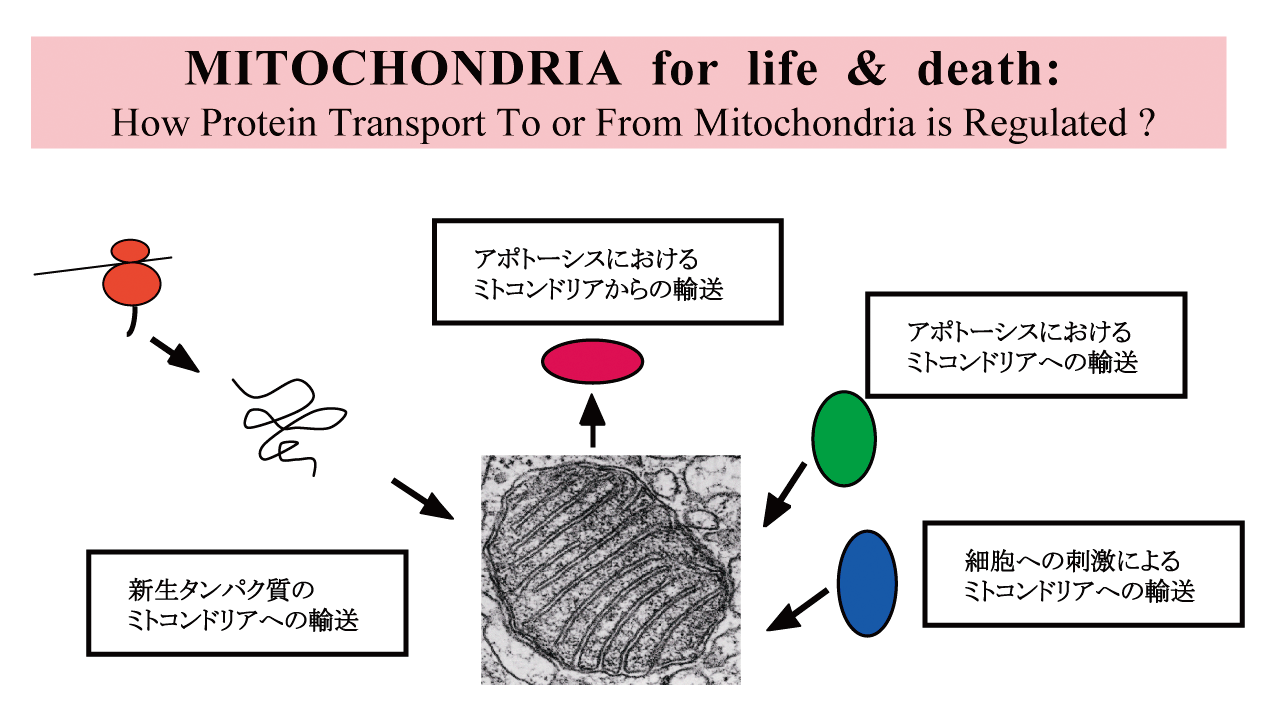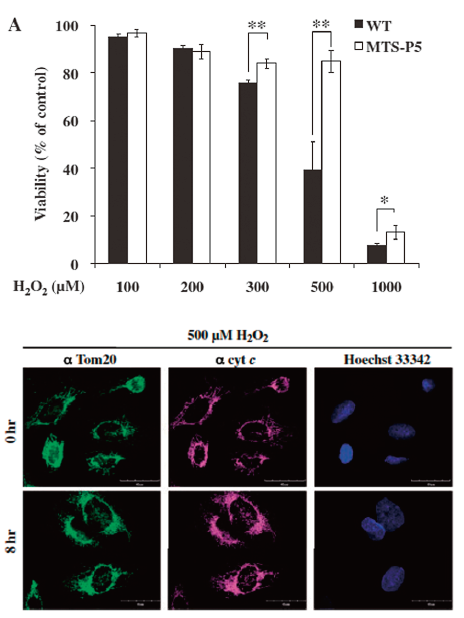フロンティアバイオサイエンス学科
 小宮 徹(こみや・とおる)
小宮 徹(こみや・とおる)
Tohru Komiya
専門分野/分子細胞生物学
研究キーワード/ミトコンドリア、細胞死
職位:准教授
学位:博士(理学)(九州大学)
- 九州大学大学院医学系研究院博士課程修了
- 九州大学大学院医学系研究院助手を経て本学へ
研究テーマ

(上図)ミトコンドリアを構成するタンパク質のほとんどは、細胞質で合成された後、ミトコンドリア内に取り込まれる(図中、左の経路)。取り込まれたタンパクの中には、細胞死を誘導する刺激によりミトコンドリア外に出ていくもの(図中、中央の経路)やミトコンドリアに集積してくるもの(図中、右上の経路)がある。細胞死誘導以外の刺激により、ミトコンドリアに集積するタンパクの例もある(図中、右下の経路)。これらの局在化の機構については未だ不明な点が多い。

細胞小器官(オルガネラ)のひとつであるミトコンドリアは、細胞内に於けるエネルギー産生の場であると同時に、様々な代謝反応が行われており、古くからよく研究されてきた。最近の研究から、ミトコンドリアは細胞死にも深く関係することが明らかになった。すなわち、ミトコンドリアは細胞の生と死の両面に関わっているオルガネラであると言える。したがって、ミトコンドリアの機能の破綻は種々のエネルギー代謝系や細胞増殖系の異常を引き起こし、重篤な場合、様々な病気の原因となることは、想像に難くない。事実、糖尿病、がん、神経変性疾患等の原因がミトコンドリアの機能の異常によるものであるという結果が数多く報告されている。しかしながら、その詳細な機構については、十分に解明されていない場合が多い。本研究室では、(1)ミトコンドリアのタンパク質の局在化の分子機構と、(2)酸化ストレス誘導性細胞死とミトコンドリアの関係を明らかにすることを研究テーマとして研究を行っている。
キーワード:ミトコンドリア、細胞内タンパク輸送、細胞死、酸化還元システム
(中図)ミトコンドリア局在型P5安定発現細胞(MTS-P5)における細胞死の抑制。H2O2処理48時間後の細胞の生存率をトリパンブルー排除法にて調べた。コントロールの細胞にくらべて、MTS-P5では細胞死が抑制されている(参考文献2より抜粋)。
(下図)ミトコンドリア局在型P5安定発現細胞(MTS-P5)におけるcytochrome c放出の抑制。H2O2処理8時間後の免疫染色の結果を示した。MTS-P5ではcytochrome cの放出が抑制されている(参考文献2より抜粋)。
| 研究の応用領域 | 産官学連携で求めるパートナー |
|---|---|
| 高次生命活動におけるオルガネラの機能解析、オルガネラの機能の異常による病因の解析 | 国、地方自治体、国立研究所、医療研究機関、バイオ系ベンチャー企業 |
Topics of research
Mitochondria, one of the organelles in the eukaryotic cells, have been extensively studied. The major mitochondrial function is to generate ATP, the energy current molecule, through the tricarboxylic acid (TCA) cycle and the oxidative phosphorylation (OXPHOS). Mitochondria also carry out several important metabolic reactions such as lipid β-oxidation, urea cycle, heme biosynthesis, iron-sulfer cluster biosynthesis, to name
Our interests are divided into two main themes as follows:
(1) How a dually-localized protein is sorted between mitochondria and the endoplasmic reticulum?
Most mitochondrial proteins are nuclear-coded, synthesized on cytosolic free ribosomes as precursor with mitochondrial targeting signal (MTS), then transported to mitochondria. While extensive studies are made, some proteins are reported to be transported to dual destinations: mitochondria and the other compartment(s) in the cell. Among these we have clarif ied that P5, a member of protein disulf ide isomerase family, is transported not only to the endoplasmic reticulum, but also to mitochondria. Now we study on how P5 is sorted to these two organells and on the putative mitochondrial targeting signal(s) in P5.
(2) How are linked between the mitochondrial dysfunction(s) and oxidative stress-induced cell death?
Defects in mitochondrial function cause not only a reduced energy production, but also an increased generation of reactive oxygen species (ROS), damage on mitochondrial morphology (in particular cristae), and if such defects are severe, damaged cells are destined to cell death. On the other hand, mitochondrial dysfunction has been suggested to be associated with numerous diseases, including cancer, diabetes, and neurodegenerative disease (Parkinson’s disease, Alzheimer’s disease, Huntington’s disease, Amyotrophic Lateral Sclerosis, etc.). Despite its signif icance and extensive studies, in many cases, the relationships among oxidative stress-induced cell death, mitochondrial dysfunction, and causative ef f ect(s) on diseases described above, are not well clarif ied so far.
Recently we have found that mitochondrial P5 suppresses the oxidative stress-induced cell death. Now we study the molecular mechanism(s) underlying the cell death suppression, and the relationships between intracelluar metabolism and cell death mechanisms.
主な業績論文等
Key words:mitochondria、intracellular protein transport、cell death、oxidative stress
- Honjo, Y., Horibe, T., Torisawa, A., Ito, H., Nakanishi, A., Mori, H., Komiya, T., Takahashi, R. and Kawakami, K. (2014) Protein Disulfide Isomerase P5- Immunopositive Inclusions in Patients with Alzheimer’s Disease., J. Alz. Dis., 38, 601-609.
- Shitara, Y., Tonohora, Y., Goto, T., Yamada, Y., Miki, T., Makino, H., Miwa, M. and Komiya, T. (2012)Mitochondrial P5, a member of protein disulf ide isomerase family, suppresses oxidative stress-induced cell death., J. Biochem., 152, 73-85.
- Kamemura, K., Ogawa, M., Ohkubo, S., Ohtsuka, Y., Shitara, Y., Komiya, T., Maeda, S., Ito, A. and Yoshida, M. (2012) Depression of mitochondrial metabolism by downregulation of cytoplasmic deacetylase, HDAC6., FEBS Lett., 586. 1379-1383.
- Kimura, T., Horibe, T., Sakamoto, C., Shitara, Y., Fujiwara, F., Komiya, T., Yamamoto, A., Hayano, T., Takahashi, N. and Kikuchi, M. (2008) Evidence for Mitochondrial Localization of P5, a Member of the Protein Disulf ide Isomerase Family. J. Biochem., 144, 187-196.
- Suzuki, H., Okazawa, Y., Komiya, T., Saeki, K., Mekada, E., Kitada, S., Ito, A. and Mihara, K. (2000) Characterization of rat TOM40, a Central Component of the Preprotein Translocase of the Mitochondrial Outer Membrane. J. Biol. Chem., 275, 37930-37936.






